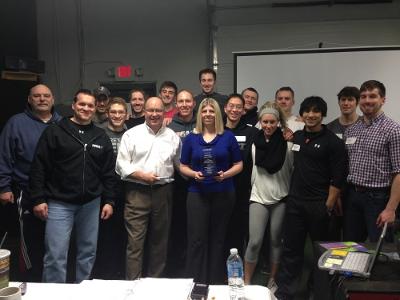This was my third time through the Postural Restoration Institute’s (PRI) Postural Respiration course (1 home study + 2 live courses). I’ve been super busy since this course, and frankly a little overwhelmed at how incredible it was. This marked the first PRI course hosted by our gym (IFAST), but you know I have to talk about the whole weekend and not just the course.
Friday
With Ty, our night trainer, on location in Florida, I was filling in Friday night coaching sessions when past interns and their friends started arriving. The one and only Grant Gardis, weightlifting coach extraordinaire, was present to get worked on for an ailing knee and coaching like an assembly line.

The wrapping up of IFAST coaching led into a generous family dinner orchestrated by Bill Hartman and the woman behind the scenes, Kirsten Shaw. It was so great to catch up before a two-day intensive mind penetration. Even driving to and from the airport is fun when you have Connor Ryan and Eric Oetter.
If you didn’t notice above, I would like to point out Kyle O’Flaherty’s photo bomb.
Saturday
After an early breakfast on Saturday with Eric, it was time for Ron Hruska, who was joined by his “third wife” Jennifer Gloystein. He began by asserting his dominance – no slides necessary – just riffing on what the big picture is, how this course is only a piece of the puzzle, and general PRI-isms. This serves well to get everyone on the same page. For me, this is a helpful brain warm up.
This course is about getting things to pump.
Pumping allows for exchange. The most basic example is respiration.
If you can’t oscillate, you’re dead.
Consider frequency, which is something you may remember from courses like physics. We all have “hertz” in our body. Respiration, mastication, circadian rhythm… it’s everywhere, and respiration is the slowest oscillation in the body.
Then, I start to wonder, “Why do we like music?” So I got the book Ron recommended (yes, it’s sitting on my desk already, thanks to Amazon Prime).
I’ve talked about a zone of apposition (ZOA) before, but it’s equally accurate to call it a zone of aspiration. You need the aspiration to breathe better so that you can use your appendages. You need a diaphragm that works for respiration instead of posture to have the aspiration to do things.
Asymmetry is Natural
There aren’t two sides that are even close to symmetrical.
This becomes more and more apparent as you read and explore. I was all up in the thorax of a cadaver a few months ago and the asymmetry is obvious. If you get the opportunity to do this, I encourage you to go explore.
They can’t walk into your clinic with symmetry because they wouldn’t walk into your clinic.
If you think in symmetry, you underestimate the system as a whole. Walking is impossible if you can’t get asymmetrical. Remember you have two lumbar spines – a left one and a right one. A left diaphragm works posturally to center you over a right side. Both the left and the right diaphragms are good at getting air into the left lung when you’re on your right leg. And you’re living with a brain that says, “Survive on the right side.”
You cannot be left dominant. I’ll show you the literature.
I need to read more. He also added that people who are left-handed will be ambidextrous.
Under every symmetrical movement is an asymmetrical challenge.
Understand that even when you’re squatting or deadlifting, you need to consider the underlying asymmetry. The brain wants the right leg because it’s more stable over there.
You Orthopedic-Minded Therapists!
Early on, Ron did the coolest thing to demonstrate how these concepts are not orthopedic, but neurologic. He stood on everyone’s left the whole time, but told us to freeze as he walked to the right side of the room.
With a rigid body, my eyes followed him to the right.
1 o’clock: doing okay
1:30: bad things are happening
2 o’clock: very dizzy
2:30: full-blown anxiety
He hung out at my 2:30 for a few seconds and asked us if we wanted him to move back.
God yes.
2 o’clock: so much pressure in my head
1:30: WILL THIS EVER END?
1 o’clock: sigh of relief
12 o’clock: melted into my seat
Ron always stands on the audience’s left when he speaks because he wants them to be able to learn. A brain cannot learn if it’s preoccupied (multi-tasking is a myth).
Does the cortex you own understand inhalation?
A pectus, where the sternum area looks concave, is the first sign the cortex doesn’t understand inhalation. “You’ll get real smart if you start looking at pectuses.”
“I can touch your breastbone and tell whether your neck is flat.” When you use a balloon, you aren’t working the mechanicoventilatory system, you’re working the cortex.
Today we’re going to take a hand (or four) to guide neurology [not respiration].
The manual techniques are guiding the patient’s mind, not simply guiding sternums down. As he said after a sternal repositioning technique, “Those three bones all knew what was happening.” The sacrum, sternum, and sphenoid are linked by neurology.
Before you can take care of hyperinflation, you need to get air out.
You can’t fill a lung that’s already filled. Learn to exhale. Whitney Houston joke.
Why is Neutrality Important?
There are many ways to define neutrality, but for the respiration-minded, it means the diaphragm can contract without the expense of extension. This is specifically important in the spine, but the whole system extends.
I would pay you for your right lung because at least I can use it.
If you can’t use your right lung, you aren’t neutral. Until you figure out how to use it, you’re lifting weight even when you aren’t weightlifting.
We talk about these more abstract concepts a lot (Heidi Wise had a good piece on the PRI Vision blog). You can’t “feel” the floor. Your body feels heavy. You feel slow.
Picture someone who can’t find a reference. They grind their teeth at night. They like when their shoulder clicks. They can’t get off their right leg. These people use their extensors to pull their feet away from the floor and their heads down onto their thorax. These people can’t feel the floor. They feel heavy. They can’t laugh. They can’t enjoy music. Ron had a case study of a roofer who was having these problems.
There are a lot of roofers out there sitting behind keyboards. They’re called repetition.
Why would I help this person get their strength back if they can’t use it?
If you’re going to change a pattern with a pattern, you will fail.
It is the position that shuts off the the system; a position that isn’t threatening. You can’t restore neutrality without position, and that must come first.
A Cootie Bug Thorax
She is not a patellofemoral, shoulder, etc. patient. You treat that and you’ve failed.

Ron loves the cootie bug toy because in order to play with a cootie bug, you need a thorax first.
Pedestrian walking requires a cootie bug thorax.
Gait that isn’t alternating (i.e. you’re using a right leg and a left kickstand instead of two legs) leads to an overactive neck.
Create left cootie bugs.
You need left abs to oppose a left diaphragm and overcome the right diaphragm.
Treatment
You need three things when treating a thorax:
- Maximize inhalation on the right.
- Maximize exhalation on the left.
- Alternate.
This is the biggest takeaway from the course. This is applicable immediately.
What’s the difference between a hand on a thorax and a wall? NADA.
The Postural Respiration course has a lot of manual techniques where the therapist helps the patient find neutrality. These aren’t always necessary to use. Always go to non-manual techniques first when treating someone because they are stronger teachers. This is just like how you remember more when you perform an activity as opposed to listening to a lecture.
In a non-manual technique, we can use something like a wall to give the patient a reference. With manual techniques, my hands become the reference. Now I’m asking myself, “How will I give you a reference?“
One thing that I’ve been using with a lot more success lately is the cue “knees forward” instead of telling them to tilt their pelvis. This helps reduce abdominal tone for the repositioning techniques. I’ve also tried using more verbal cues so that they can make their own representations of the activity they are doing. It doesn’t work all the time, but it sticks better.
These runners. These SICKOS. Right and left doesn’t exist in their vocabulary, only extension.
This is hilarious, but it’s not limited to runners. I just taught at a USA Weightlifting course full of Crossfitters. They feel great when they work out, but they can’t come down. They can’t shut off. They can’t relax. So they just train more often. Again, why would I help you get your strength back if you can’t use it? In regards to alternating activity (#3 above), ask if you can rotate that vertebra to the right without coming off the left leg. Ask if you can rotate a central tendon to the right from the left side. Ask if your sacrum, sternum, and sphenoid are alternating – because that’s gait.
When I hear “dys-” and “shoulder”, I think lat.
The lat is a road bomb to your body. The Achille’s tendon may be the largest tendon in the body, but the lat tendon is the strongest. “You can never annihilate a lat enough.“
I’m gonna get every single millimeter of my God-given mediastinum.
Left serratus anterior pulls the ribs back to open up that left posterior mediastinum. How am I going to give you a reference for your posterior mediastinum? Maybe I make sure you have the correct chair at work and ask you to feel your back in it every once and a while.
Saturday Night Dinner
I had the amazing opportunity to go to dinner with Ron, Jenn, Bill, Robert Lardner, and Richard Ulm. The knowledge at the table was overwhelming, and it wasn’t from me. If we mapped the concentration of knowledge like you would to should charge distribution of a molecular compound, the table would look very similar to the electrostatic potential map of lithium iodide.
Our server didn’t know what to do when Rich, Robert, and Ron all ordered the right rack of ribs.
And it’s not a PRI party if someone doesn’t start talking about right trunk rotation (ribs moving up on the right and down on the left).
Suffice to say this may have been the best dinner ever.
Sunday = Biobehavior
After an interesting discussion at dinner, Ron opened up Sunday a little closer to his home. He wrote a bunch of inputs into the system on the board: visual, vestibular, proprioceptive, etc. They were big words that I don’t remember.
The stuff in the manual is evidence-based.
I do manual work to open up something behaviorally [not manually].
He told us to write down the above heading on our note paper. Ron is all about the vestibular system. This ties back to the cervical-cranio-mandibular course I took a few weeks back.
I’m not teaching you how to open up a chest wall, I’m teaching you how to teach them to open up a chest wall.
As I alluded to above, you’re guiding neurology, not adding sarcomeres in series. And “the sternum is the best thing we have for regulating.”
I like working with a patient with CVA because now when I do this stuff, suddenly it’s okay. “They have neglect!”
Those who don’t understand will criticize.
I’m never worried about physical trauma, I’m worried about psychological trauma.
More biobehavior. Repect psychology. See if your patient can articulate their thoughts into words. Talk to them. What worries them?
The number one things that scares me these days is Lasik surgery.
After Lasik, you’ll be taking in a lot more information than you normally do. How do you shut down such a huge input?
If I don’t pretest, I can’t understand pathology. If I get you neutral and don’t treat the pathology, I won’t be able to keep you there.
I’ve been picking up more assessments at IFAST lately, so I shadowed Bill one day to hone in my skills. This point was made to me then. Being neutral is only the tip of the iceberg. Make it stick.
Before I get that dental impression made, I’m going to free up the first rib.
Subclavius and scalenes on the right side can get really active to try to open up the closed right upper ribs. This is called Superior T4 Syndrome in PRI. I need to regulate everything I can before I get some sort of dental intervention that will hold me there because I don’t want it to hold me in the wrong position.
Similarly, if you have a left pec major that won’t shut off, you need to give it a reason to shut off. Stretching is not that reason. You need to restore position of an S bone called a sternum to regulate neurology, otherwise the brain will keep telling it to turn on so it can open up the right chest wall.
If I have someone who can’t feel what I’m trying to do, I probably need more hands.
These systems are locked up and will take some work to unlock. The manual techniques you use for these people will need more than just one set of hands. Find a mom or a co-worker.
Our room was full of jacked lifting bros, also known as extended bros. There were only a handful of women. Ron mentioned that this type of “clientele” is not normal, but it’s pretty common for the people I get to see in the gym. If non-manual techniques don’t work, these people are going to need more than two hands on them.
All in all, Ron was great again. The course wouldn’t have gone nearly as well if he hadn’t brought Jenn along with him, so hats off to her as well.
Post-Course Dinner
Not one to pass up a dinner, Bill invited everyone over to his place, catered by the lovely Mayor Lisa. The place was packed. So packed that I had to skip my hockey game to attend.
This was the largest family dinner I’ve ever been to. And the loudest.
Closing
Robert Lardner had a great point to make during the second day.
This stuff has been done for [hundreds of] years, but we’re just coming back to it because we’re just starting to affirm it.
Robert is a very smart man who is paying attention to what goes on around him. I don’t know the history of yoga, but apparently that’s been going on for quite some time.
Hope to see you at the next course!

Miscellaneous Quotes
Don’t get wet, drown with this stuff.
Learn more. And don’t stop.
…a major neuromuscular disease called a spouse.
Lost my mind when he said this.
We treat our cars better than our patients.
Get a tune up and pay attention to the system.
You need to attend this course.
If you liked this post, please share it with someone who would like it, subscribe so you don’t miss the next one, and leave a comment below telling me what course you’re going to next.



![The right rack of ribs. [From left]: Robert, Ron, Richard](https://lancegoyke.com/wp-content/uploads/2014/03/Ribs-right-rack.jpg)
![Right trunk rotation. [From left: Robert, Ron, Richard]](https://lancegoyke.com/wp-content/uploads/2014/03/Right-rib-rotation.jpg)
Great write up, Lance. It was cool to read your takeaways to reflect after taking Respiration in NYC a couple weeks ago. And I will be buying the music book…
Kyle,
Email me and tell me what you thought of the course. I’m always up for some shop talk.
Great review of the course!
Just completed the postural respiration home study course (sent it away 15 minutes ago) and did the Myokin home study last month. Both amazing. I’m really wanting to get the PRT designation and am looking at the Impingement and instability course in November. Have you had a chance to take it? Or are you looking to take it in the future? Would you recommend taking the first two course (or attending them) to get a better understanding of the base material before challening the second course?
Thanks Chris!
I actually took I&I last November! (https://lancegoyke.com/impingement-and-instability-a-recap)
If you feel confident in what you know and you’re excited about an upper level course, I wouldn’t avoid going (especially if it’s within driving distance). Getting more perspective by attending a course can’t hurt.
I would recommend getting some experience with incorporating PRI into your own system and working on patients/clients. I think that would help you take away more from the course.
Does that help?
-Lance
Nice breakdown Lance. Glad to see someone finds Ron’s PRIisms as funny as me.
Haha, thanks Steve! A few friends and myself actually have a group text where we trade PRIisms. It’s hilarious every time.